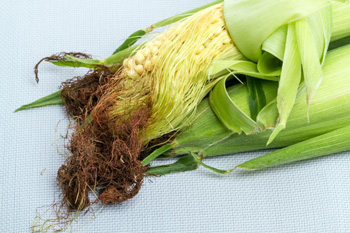
Sarah Wilson
If you’re like me, you enjoyed corn on the cob this summer. And, if you’re like me, you weren’t thrilled to deal with the golden toupee of corn silk between the husk and the tasty kernels. The last time I was removing those, I wondered, “Why are these here? What purpose do they serve?”
After digging around a bit, I can now tell you that corn silk is about reproduction. So, you and I are about to go behind closed doors for a look at the incredibly tame world of corn porn. Are you all ears?
Here’s a hint: there is one strand of corn silk per kernel, about 800 strands per ear. These strands play a critical role in kernel fertilization.
Maybe you’ve unhusked an ear only to find a disappointing mixture of dried-up pre-kernels and sweet, juicy corn. That’s an ear that was inadequately fertilized or was stressed during the fertilization.
Don’t blame our hard-working pollinators for such mishaps. Corn is wind-pollinated. Wind-pollinated plants are easy to identify because they make no effort to tempt insects with colorful blooms. They don’t have to. Air currents need no such seduction.
In corn, the tassels atop the stalks release pollen. This pollen is super light, weighing 150-500 nanograms (1 billion nanograms in a gram). The smallest puff of breeze can disperse them hundreds of feet from that plant, though such distances pose hazards.
Those minuscule pollen grains can dry out quickly; speed is of the essence. When bouncing around in the air, colliding with leaves and stalks, it’s the luck of the draw to land on silks. Silks help the grains out by being covered with tiny hairs, which you are welcome to think of as little botanical catcher’s mitts. As soon as a grain of pollen is caught on a strand, it sets about developing a “pollen tube” that extends inside. Capable of growing up to a foot in one day, that tube is an express lane directly down the silk road. Upon reaching the strand’s predetermined destination, that waiting ovule, the pollen deposits its genetic material. And that, dear friends, is how a kernel of corn is born.
Next time you’re cleaning those annoying strands of silk off your corn on the cob, thank them. They made your meal possible.
Nature is amazing.


